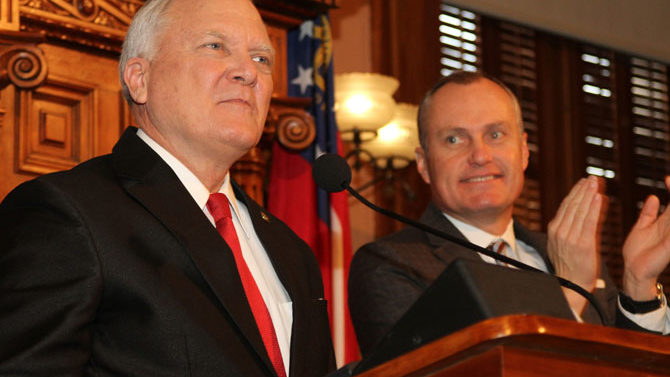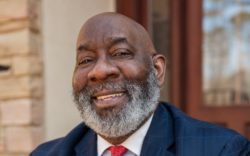Public education has been a carnage in Georgia since the recession began in 2008. Budgets have been cut by billions of dollars, school years were shortened, and 9,000 teachers lost their jobs as class sizes increased.
Gov. Nathan Deal pronounced that era over last week when he announced that he would add $547 million to K-12 education in the budget he submitted to the state legislature.
“Since spending on education has always been the largest part of our state budget, representing over half of all spending, it was to be expected that it would be reduced during these hard times,” Deal said during his State of the State address Wednesday, Jan. 15. “However, during my administration, funding for education has increased by over $930 million.”
Sounds great, right? It doesn’t tell the whole story, though. Education spending in fiscal 2015 will still be lower than it was in fiscal 2008 (July 2007—June 2008), the last budget year before the economy cratered. At the same time, K-12 enrollment has risen by 74,000 students. Adjusted for inflation, if Deal’s budget is approved, the state will be spending almost $300 less per student than it did seven years ago—more than $1,000 less when adjusted for inflation.
The budget Deal submitted last week reduces the recession-driven “austerity cuts” by $314 million, but the cuts started out at $1.1 billion, so education is still underfunded by about $800 million compared to pre-recession budgets. And even before the austerity cuts, lawmakers never fully funded education, according to the Quality Basic Education formula they established in the 1980s.
“It is a down payment on solving the problem,” said Alan Essig, director of the Georgia Budget and Policy Institute, an Atlanta think tank. “It doesn’t solve the problem.”
State Sen. Jason Carter (D-Decatur), the likely Democratic nominee for governor, accused Deal of boosting K-12 funding simply as a political ploy. He proposed separating education from the rest of the budget to protect it from meddling legislators.
“Don’t let the governor’s pledge to improve public education and technical job training fool you,” Carter said. “The single biggest failure of our current leadership in Georgia is the dismantling of our education system.”
Rather than giving teachers pay raises, as many observers expected, Deal instead opted to let local school districts decide how to spend the extra money—to add instruction days back to the school calendar, get rid of furlough days or give teachers raises. Essig said that flexibility was the right move. During budget hearings at the state capitol last week, though, that tactic seemed to catch School Superintendent John Barge, who is running against Deal in the GOP primary, off guard.
“I’m not looking the gift horse in the mouth,” Barge said. “People asked me if I knew about this. I was surprised, but I was pleasantly surprised.”
The flexibility is welcome to Clarke County School District administrators, who have laid off dozens of parapros, furloughed teachers and eliminated school days to close budget shortfalls during the recession. Chief Financial Officer Larry Hammel said he expects the district to receive an additional $2 million due to reduced austerity cuts next year, as well as an unknown but small amount tied to enrollment growth. (CCSD enrollment is holding steady around 12,000, according to spokeswoman Anisa Sullivan Jimenez.) The district’s deficit this year is $3 million.
Hammel said he is not sure yet whether the district would use the money to increase school days from the current 176 to what used to be the state-mandated number, 180, or end furloughs. (The current year’s budget included five furlough days, but two were canceled due to higher-than-expected revenue.) “That would definitely be something for us to put on the planning board and look at,” he said.
Rehiring parapros—who were controversially laid off in 2012—is unlikely, according to Hammel. Nor should teachers expect raises, Essig said, although they would see their paychecks return to normal without the unpaid days off.
In his State of the State speech, Deal tied education to economic development, bragging about the 217,000 jobs that he said have been created during his term (although the state lost 300,000 jobs during the recession, and many of the new ones pay less than those they replaced, according to a GBPI study).
“Finally, when we’re tying it to economic development, everybody’s getting on the bandwagon,” said state Rep. Spencer Frye (D-Athens). “I’m happy.”
Higher Education Falls
Colleges and universities have suffered a similar fate to K-12 in recent years, with state funding falling from $2.1 billion in 2008 to a low of $1.7 billion in 2012. It’s $1.9 billion in Deal’s proposed 2015 budget.
The difference is that, while local school boards can raise property taxes (at least the ones that aren’t maxed out at 20 mills), the University of Georgia cannot. Instead, the shortfall landed on the backs of students in the form of higher tuition and fees and fewer HOPE Scholarship benefits.
As state spending has dropped, enrollment is up 9.4 percent, University System Chancellor Hank Huckaby told the House and Senate appropriations committees last week. State support per student is now equal to 1996—without adjusting for inflation, he said.
“The rising cost of a college education is a matter I take very seriously,” Huckaby said. “On every campus I visit, a student will share the challenges of staying in school with higher tuition and fees, which may be exacerbated by a job loss at home.”
The system is dealing with the problem by trying to become more efficient, limiting tuition and fee hikes and exploring cheaper online options for textbooks, he said.
While students pay more, University of Georgia faculty and staff have gone without raises for six years. That will change—at least for a few. Deal’s budget includes $10 million for merit-based raises and raises aimed at recruiting and retaining key employees in the university system, the equivalent of 1 percent raises for everyone. However, that doesn’t mean everyone will get a 1 percent raise. It will be up to institutions and departments to decide who gets how much. “There will be winners and losers, and there will be a lot more losers than winners,” Essig said.
Huckaby acknowledged criticisms that the university system spends too much on bricks and mortar and not enough on people. He requested funding for just two new buildings this year, one of them a new $50 million science learning center at UGA.
For students at two-year schools like Athens Tech, Deal—after forcing thousands of students to drop out by raising the grade point average requirement for HOPE Grants—called for a new Zell Miller HOPE Grant that will pay 100 percent of tuition for students with a 3.5 GPA or better. He also proposed $10 million for low-interest loans for technical college students and additional funding in the fields of welding, health care technology, diesel mechanics and information technology.
Winners and Losers
Deal also included funding for 130 residencies at Athens Regional Medical Center and St. Mary’s Hospital for graduates of the UGA-Georgia Regents University medical school partnership at the old Navy school. “Our health care in Athens and the surrounding area is going to be even better than it already is,” Frye said.
Another proposal that could benefit Athens is $35 million to deepen the Port of Savannah to allow larger barges. Caterpillar ships the products it produces in Bogart from the port.
Most state agencies, though, won’t get any more money after years of 20, 30, even 40 percent cuts. The state Environmental Protection Division, for example, will still lack funds to aggressively enforce environmental laws. Nurses, hairdressers and other professionals will still face long waits getting their licenses renewed by the Secretary of State’s office.
That’s because Deal had about $1 billion in addition revenue from the economic recovery to play with, and he put almost all of it into reducing K-12 austerity cuts, automatic increases to Medicaid, PeachCare and pensions, a mental health care court settlement and salary increases for a few state employees, Essig said. “It all sounds like a lot of money, but it’s all being spent on four–five things that are the the cost of doing business,” he said.
Like what you just read? Support Flagpole by making a donation today. Every dollar you give helps fund our ongoing mission to provide Athens with quality, independent journalism.










